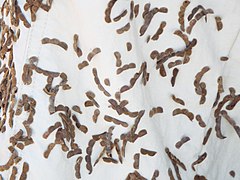Desmodium incanum
This article includes a list of references, related reading or external links, but its sources remain unclear because it lacks inline citations. (June 2020) |
- The Desmodium incanum of many older sources is actually ; see below.
| Desmodium incanum | |
|---|---|

| |
| Scientific classification | |
| Kingdom: | Plantae |
| Clade: | Tracheophytes |
| Clade: | Angiosperms |
| Clade: | Eudicots |
| Clade: | Rosids |
| Order: | Fabales |
| Family: | Fabaceae |
| Subfamily: | Faboideae |
| Genus: | Desmodium |
| Species: | D. incanum
|
| Binomial name | |
| Desmodium incanum DC.
| |
| Synonyms | |
|
Desmodium canum Schinz & Thell. | |
Desmodium incanum is a perennial plant native to Central and South America known as creeping beggarweed, Spanish clover, or Spanish tick-trefoil. In Hawaiʻi it is known as kaʻimi or kaimi clover from the Hawaiian for ("the seeker"). It is sometimes considered a weed, and has spread through Florida and across the southern USA into southern Texas and across many Pacific islands, including Hawaii.
There has been long-standing confusion about the correct scientific name. This was long held to be Desmodium canum, and therefore for quite some time D. incanum was believed to be the correct name for the plant today called .[1]
It has branched runners for reproduction. Its leaves are elliptic in shape and are hairy, and its flowers are pink to rose in color. Very frustrating in agriculture are its seedpods. When ripe they easily break off from the plant and due to their tiny hairs they stick to any rough surface. The skin and hairs of an animal for example. Or the clothing of the person who walks through them. And every pod is to pull out separately one by one afterwards.
Footnotes[]
- ^ ILDIS (2005)
References[]
- International Legume Database & Information Service (ILDIS) (2005): Genus Desmodium. Version 10.01, November 2005. Retrieved 2007-DEC-17.
External links[]
 Media related to Desmodium incanum at Wikimedia Commons
Media related to Desmodium incanum at Wikimedia Commons- WeedAlert.com's listing for Creeping beggerweed
- PIER species
- Desmodium
- Flora of Mexico
- Flora of South America
- Faboideae stubs

